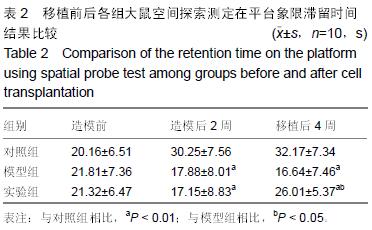| [1] Howard KL, Filley CM. Advanees in genetic testing for Alzheimer’s disease. Rev Neurol Dis. 2009;6(1): 26-32. [2] Salminen A, Ojala J, Kauppinen A, et al. Inflammation in Alzheimer’s disease:amyloid-beta oligomers trigger innate immunity defence via pattern recognition receptors. Prog Neurobiol. 2009;87(3): 181-194. [3] Jakob-Roetne R, Jacobsen H. Alzheimer’s disease:from pathology to therapeutic approaches. Angew Chem Int Ed Engl. 2009;48(17):3030-3059. [4] Buckingham SD, Jones AK, Brown LA, et al. Nicotinic acetylcholine receptor signalling: roles in Alzheimer’s disease and amyloid neuroprotection. Pharmacol Rev. 2009;61(1):39-61. [5] Lovell MA. A potential role for alterations of zinc and zinc transport proteins in the progression of Alzheimer’s disease. J Alzheimers Dis. 2009;16(3): 471-483. [6] Deane R,Bell RD,Sagare A,et al.Clearance of amyloid-beta peptide across the blood-brain barrier: implication for therapies in Alzheimer’s disease. CNS Neurol Disord Drug Targets. 2009;8(1):16-30. [7] Saxena U. Lipid metabolism and Alzheimer’s disease: pathways and possibilities. Exp Opin Ther Targets. 2009;13(3):331-338. [8] 张翼.中国老年人口的家庭居住健康与照料安排第六次人口普查数据分析[J].江苏社科学,2013,(1):57-65. [9] 樊清华,郑建中.老年痴呆患病率及危险因素调查[J].现代预防医学,2011,38(15):3029 -3033. [10] Proekop DJ. Marrow stromal cells as stem cells for nonhemato Poietic tissues. Seienee 1997,276:71-74. [11] Friedenstein AJ, Gorskaja JF, Kulagina NN. Fibroblast Preeursors in normal and irradiated mouse hemato Poietic organs. Exp Hematol. 1976;4:267-274. [12] Castro-Malas Pina H, Gay RE, Resniek G, et al. Charaeterization of human bone marrow fibroblast colony-forming cells (CFU-F) and their progeny. Blood. 1980;56:289-301. [13] Bab I, Ashton BA, Gazit D, et al. Kinetics and differentiation of marrow stromal cells in diffusion chambers in vivo. J Cell Sci. 1986;84:139-151. [14] 中华人民共和国科学技术部.关于善待实验动物的指导性意见[M].2006-09-30. [15] Golloib LG. Behavioral changes in induced by aluminum in drinking water. Dementia. 1991;2(2):278. [16] 张魁华,赖世隆,王奇,等.补肾益智方对老年性痴呆模型动物空间探索学习记忆功能的改善作有[J].中草药,2002, 33(12):1093. [17] Morris RG, Garrud P, Rawlins JN, et al. Place mavigation impaired in rats with hippocampal lesions. Nature. 1982;297(5868):681. [18] Gotherstrom C, Ringden O, Tammik C. et al. Immunologic ProPerties of human fetal mesenchmal stem cells. Am J Obstet Gyneeol. 2004;190:239-245. [19] 徐如祥.阿尔茨海默病的分子机制与神经干细胞移植治疗[J].老年医学与保健,2004,10(3):177-180. [20] Masters CL, Beyreuther K, Henryk M. Wisniewski and the amyloid theory of Alzheimer’s disease. Alzheimer’s Dis. 2001;31:83-86. [21] Lewis J, McGowan E, Roekwood J, et al. Neurofibrillary tangles, amyotrophy and progressive motor distubance in mice expressing mutant (P3o1L) tau protein. Nat Genet. 2000;25:402-405. [22] De LaTorry JC. Critieally attained threshold of cerebral hypoperfusion: can it cause Alzheimer’s disease. Ann N Y Acad Sci. 2000;903:424-436. [23] Tanimukai H, Grone I, Iqbal K. Upregulation of inhibitors of protein phosphatase in AIzheimer’s disease. Am J Pathol. 2005;166(6):1761-1771. [24] Ballatore C, Lee VM, Trejanowski JO. Tau mediated neuro-degeneration in Alzheimer’s disease and related disorders. Nat Rev Neurosci. 2007;8(9):663-672. [25] Li Y, Qin HQ, Chen QS, et al. Neurochemical and behavioral effects of the intrahippocampal co-injection of B-amyloid Protein 1-40 and ibotenic acid in rats. Life Sci. 2005;76:1189-1197. [26] Rosato-Siri M, Cattaneo A, Cherubini E. Nieotine-induced enhancement of synaPtic Plastieity at CA3-CA1 synapses requires GABAergic interneurons in adult anti-NGF mice. J Physiol. 2006; 576:361-377. [27] Fillit HM. The pharmaco economics of Alzheimer’s disease. AM Jmanag Care. 2000;6(22Suppl):S11. [28] Me Lellan ME, Kajdasz ST, Hyman BT, et al. In vivo imaging of reactive oxygen species specifieally associated with thioflavine s-positive amyloid plaques by multiphoton microseopy. J Neurosci. 2003; 23(6): 2212-2217. [29] Bons N, Mestre N, Ritehie K, et al. Identification of amyloid-beta protein in the brain of the small, short-lived lemurian primate microcebusmurinus. Neurobiol Aging. 1994;15(2):215-220. [30] Burgermeister P, Calhoun ME, Winkler DT, et al. Mechanisms of cerebrovascular amyloid deposition. Lessons from mouse models. Ann N Y Acad Sci. 2000: 903:307-316. [31] Redei EE, Ahmadiyeh N, Baum AE, et al. Novel animal models of affective disorders. Semin Clin Neurop Psychiatry. 2001;6:43-67. [32] Duman RS. Path ophysiology of depression:the concept of synaptic plas ticity. Eur Psychiatry. 2002; 17(Supp13):306-310. [33] Wang XY, Chen J, Zhang JT. Effect of ginsenoside Rgl on learning and memory impairment induced by beta-amyloid peptide (25-35) and its mechanism of action. Yi Yao Xue Bao. 2001;36:1-4. [34] Lee JK, Jin HK, Bae JS. Bone marrow-derived mesenchymal stem cells reduce brain amyloid-beta deposition and accelerate the aetivation of mieroglia in an acutely induced Alzheimer’s disease mouse model. Neurosci Lett. 2009;450(2):136-141. [35] 徐如祥.阿尔茨海默病的分子机制与神经干细胞移植治疗[J].老年医学与保健,2004,10(3):177-180. [36] Masters CL, Beyreuther K, Henryk M. Wisniewski and the amyloid theory of Alzheimer’s disease. Alzheimer’s Dis. 2001;31:83-86. [37] Woodbury D, Sehwarz EJ, Proekop DJ, et al. Adult rat and human bone marrow Stromal cells differentiate into neurons. J Neurosci Res. 2000;61(4):364-370. [38] Cho JS, Park HW, Park SK, et al. Transplantation of mesenehymal stem cells enhances axonal outgrowth and cell survival in an organotypic spinal cord sliee culture. Neurosci Lett. 2009;454(1):43-48. [39] Kitada M, Dezawa M. Induetion system of neural and rnusele lineage cells from bone marrow stromal cells: a new strategy for tissue reconstruction in degenerative diseases. Histol Histopathol. 2009;24(5):631-642. [40] Lee JK, Jin HK, Bae JS. Bone marrow-derived mesenchymal stem cells attenuate amyloid β-induced memory impairment and apoptosis by inhibiting neuronal cell death. Curr Alzheimer Res. 2010; 7(6): 540-548. [41] Rosen WG, Mohs RC, Davis KL. A new rating scale for Alzheimer's disease. Am J Psychiatry. 1984;141(11): 1356-1364. [42] Dezawa M. Systematic neuronal and muscle induction systems in bone marrow stromal cells: the potential for tissue reconstructionin neurodegenerative and muscle degenerative diseases. Med Mol Morphol. 2008;41(1): 14-19. [43] Hermann A, Maisel M, Storch A. Epigenetic conversion of human adult bone mesodermal stromal cells into neuroectodermal cell types for replacement therapy of neurodegenerative disorders. Exp Opin Biol Ther. 2006,6(7):653-670. [44] 胡为民,Frautschy SA.β-淀粉样肽鼠脑室内灌注制作阿尔茨海默病动物模型的实验技术研究[J].山西医科大学学报,2004,35(4):336-337. |
.jpg)




.jpg)